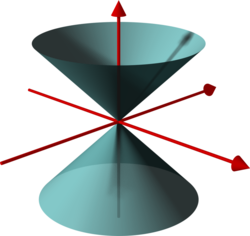These Couple Lines

The pair of lines whose direction cosines are given by the two equations above are:
If you're looking to skyrocket your preparation for JEE-2015, then go for solving this set of questions .
Image Credit: Wikimedia Cone by Lars H. Rohwedder
This section requires Javascript.
You are seeing this because something didn't load right. We suggest you, (a) try
refreshing the page, (b) enabling javascript if it is disabled on your browser and,
finally, (c)
loading the
non-javascript version of this page
. We're sorry about the hassle.
If n = 0 you find quite quickly that all the direction cosines are 0 and it is impossible to determine a line. So let's assume that n = 0 .
Since the difference between direction numbers and direction cosines is a numerical factor, and both equation are homogeneous, we can use the given equations to find a triple of direction numbers, say L , M , N with N = 0 .
We can arbitrarily choose N = 1 and use the equations to find the other two direction numbers. We have
3 L + M + 5 = 0 … ( 1 )
6 M − 2 L + 5 L M = 0 … ( 2 )
It is not hard to use (1) to eliminate M from (2) leading to
L 2 + 3 L + 2 = 0
and so L = − 2 or L = − 1
Using (1) we then see that the two possible trios of direction numbers are
a = ( − 2 , 1 , 1 )
b = ( − 1 , − 2 , 1 )
And so the cosine of the angle between the two lines is
a . a × b . b a . b = 6 1